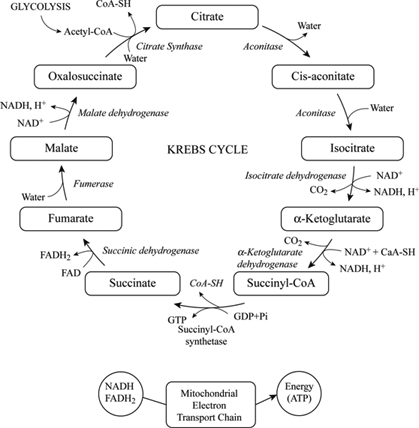Chemical energy is released as eaten food is digested giving off heat as a by-product. It connects glycolysis to the Krebs cycle b.

Definition Of Krebs Cycle Chegg Com
The reaction occurs once per glucose molecule Feedback The correct answer is.

. It is also known as TriCarboxylic Acid TCA cycle. Select each of the statements that describe the Krebs cycle A Pyruvic acid must be converted to acetyl CoA prior to entering the cycle B Most of the ATP generated during the aerobic respiration of glucose is generated during the Krebs cycle C There are 10 steps each catalyze by a different enzyme D. The Krebs Cycle or also known as the citric acid cycle as it is the first substance to be formed during the cycle is one of the stages of the cellular respiration process only of aerobic organisms occurring within the mitochondria of eukaryotic cells.
Complete oxidation of food takes place. Process involves the Krebs cycle The coenzyme NAD plays an important role in the pathway Much or most of the ATP produced is produced by oxidative phosphorylation Can generate ATP in the absence of O2 Process includes glycolysis Between 2 and 38 ATP are produced per molecule of glucose input. It produces carbon dioxide.
A two carbon molecule called NADH is produced in the preparatory steps of the Krebs. I The waste product of the Krebs cycle is oxygen ii Complete oxidation of food takes placeKrebs cycle involves step by step breakdown of pyruvic acidlactic acid to produce ATP and CO2. Which of the following correctly compares capitalism socialism and communism.
Select all that apply. ATP is produced with the help of the electron transport chain. Carbon dioxide is given of c.
-The end product of glycolysis pyruvic acid must. It produces water and a high amount of ATP. The krebs cycle is the second stage of cellular respiration also called the aerobic stage as it occurs in the.
Diffusion describes the concentration gradient in a solution. The Krebs Cycle also called the citric acid cycle is the second major step in oxidative phosphorylationAfter glycolysis breaks glucose into smaller 3-carbon molecules the Krebs cycle transfers the energy from these molecules to electron carriers which will be used in the electron transport chain to produce ATP. Fuel molecules are broken down further in glycolysis and the ctric acid cycle Krebs cycle how food molecules reach the bodys cells and fuel cellular respiration.
Krebs cycle glycolysis. Then in the right-hand column of the table select which stage each statement describes. Use the diagram below to help you determine the stage each statement describes.
In eukaryotic cells the citric acid cycle takes place in the matrix of the mitochondria. Pyruvate is converted to a two-carbon acetyl group d. In prokaryotic cells the citric acid cycle occurs in the cytoplasm.
-During these redox reactions electrons are picked up by NAD in 3 of the steps and by FAD in 1 of the steps. Iii Electron carriers are produced by the Krebs cycle for the transportation of electron chain. CONCEPT Diffusion 14 A carbohydrate with two sugar units would be an _____.
The reaction occurs once per glucose molecule. Chemical bonds in food molecules are broken releasing energy and allowing cells to use the energy to make ATP. -The Krebs cycle is a cyclic pathway of 8 reactions 2 of which are redox reactions.
Which of the following correctly compares the structures of plant and animal cells. Select each of the statements that describe the krebs cycle. Monosaccharide Polysaccharide Carbosaccharide Oligosaccharide CONCEPT Carbohydrates 15 What is true about the Krebs cycle.
How food molecules reach the bodys cells and fuel cellular respiration. Select all that occur in the electron transport chain. Which statements accurately describe the electron transport chain.
NAD is converted to NADH e. It uses electrons released from NADH. Glucose 2 ATP Glycolysis ATP 2 net 2 NADH 2 Pyruvate cytoplasm mitochondrion 6 CO2 Krebs Cycle ATP NADH 2 FADH 02 Electron transfer phosphorylation 32 ATP Stage of Aerobic.
The cycle was first elucidated by scientist Sir Hans Adolf Krebs 1900 to. Krebs Cycle Definition. The citric acid cycle shown in also known as the tricarboxylic acid cycle TCA cycle or the Krebs cycleis a series of chemical reactions used by all aerobic organisms to generate energy through the oxidation of acetatederived from carbohydrates fats.
Cells extract and capture the energy in food molecules all at once then store it for later use. Krebs Citric Acid Cycle Steps by Steps Explanation. Most of the ATP generated during the aerobic respiration of glucose is generated during the Krebs cycle There are ten steps each catalyzed by a different enzyme There are four steps involving redox reactions Electrons removed during oxidation steps are picked up by NAD or FAD CO 2 is released at two steps The starting material oxaloacetatic acid is regenerated at the.
Iv None of the above.

The Citric Acid Cycle Cellular Respiration Article Khan Academy


0 Comments